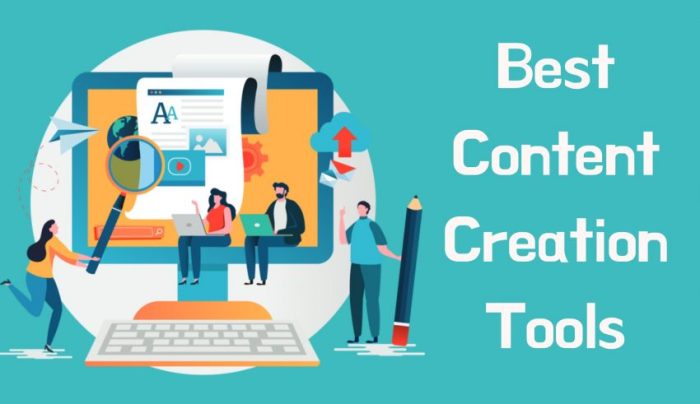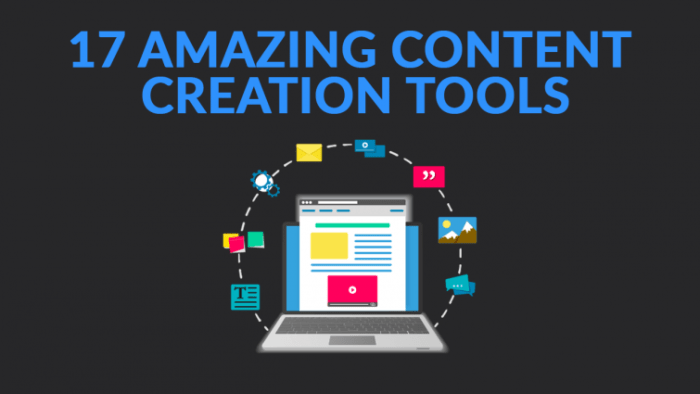Content Creation Tools, a must-have for any modern creator looking to level up their game. From streamlining workflows to boosting efficiency, these tools are a game-changer. Let’s dive in and explore the world of content creation tools!
Overview of Content Creation Tools

Content creation tools are like the Swiss Army knife for creators, helping them bring their ideas to life in various forms. These tools are designed to simplify the process of creating, editing, and sharing content across different platforms.
Types of Content Creation Tools
- Graphic Design Tools: Programs like Adobe Photoshop and Canva help creators design stunning visuals for social media, websites, and more.
- Video Editing Software: Tools like Adobe Premiere Pro and Final Cut Pro enable creators to edit and enhance videos for YouTube, Instagram, and other platforms.
- Writing and Editing Tools: Platforms like Google Docs and Grammarly assist writers in creating and refining their content with ease.
- Social Media Management Tools: Platforms like Hootsuite and Buffer help creators schedule posts, analyze performance, and engage with their audience effectively.
Popular Content Creation Tools
Canva: A user-friendly graphic design tool with a wide range of templates and customization options.
Adobe Premiere Pro: A professional video editing software used by many filmmakers and content creators.
Grammarly: An AI-powered writing assistant that helps users write clearly and effectively.
Hootsuite: A social media management platform that allows creators to schedule posts and monitor their social media presence.
Features to Look for in Content Creation Tools

When choosing a content creation tool, it is important to consider key features that can enhance your workflow and productivity. Features such as ease of use, variety of templates, and collaboration options can make a significant difference in the quality of your content.
Essential Features
- Ease of Use: Look for a tool that is intuitive and user-friendly, with a simple interface that allows you to create content quickly and efficiently.
- Templates: Choose a tool that offers a wide range of templates for different types of content, such as social media posts, blog articles, and presentations, to help you get started easily.
- Collaboration Options: Opt for a tool that allows for seamless collaboration with team members, enabling real-time editing, commenting, and sharing of content.
Comparing Pricing Models
- Freemium: Some content creation tools offer a freemium model, where basic features are available for free, but advanced functionalities require a premium subscription.
- Subscription: Many tools offer subscription-based pricing, where you pay a monthly or annual fee to access all features and updates.
- One-Time Purchase: Some tools allow you to make a one-time purchase to access the software indefinitely, without the need for recurring payments.
Importance of Integrations
Integrations with other platforms, such as social media, email marketing, and project management tools, are crucial for streamlining your workflow and maximizing the reach of your content. Look for content creation tools that offer seamless integrations with your existing tools and platforms to enhance your overall content creation process.
Benefits of Using Content Creation Tools
Using content creation tools can greatly streamline the content creation process, making it more efficient and effective. These tools offer a wide range of features and functionalities that help content creators produce high-quality content in less time.
Improved Productivity and Efficiency
Content creation tools provide templates, design elements, and editing capabilities that enable creators to work faster and more effectively. By automating repetitive tasks and offering a variety of pre-designed assets, these tools can significantly increase productivity and efficiency. This allows creators to focus more on the creative aspects of content creation rather than spending time on mundane tasks.
Maintaining Brand Consistency
Consistency is key when it comes to building a strong brand identity. Content creation tools often come with brand guidelines and templates that ensure all content produced aligns with the brand’s visual and tonal guidelines. By using these tools, creators can maintain a consistent brand image across all their content, whether it’s social media posts, blog articles, or marketing materials. This helps build brand recognition and trust among the audience.
Tips for Maximizing Content Creation Tools
When it comes to making the most out of content creation tools, there are a few key strategies that can help you create engaging content, optimize it for , and repurpose it across different platforms.
Creating Engaging Content
- Utilize eye-catching visuals, such as images, videos, and infographics, to enhance the visual appeal of your content.
- Write compelling and relevant headlines that grab the reader’s attention and entice them to click.
- Include a clear call-to-action to guide your audience on the next steps to take after consuming your content.
- Engage with your audience through interactive elements like polls, quizzes, and surveys to make the content more interactive.
Optimizing Content for
- Research and target relevant s that are commonly used by your target audience to improve your content’s visibility in search engine results.
- Optimize meta tags, titles, and descriptions to make it easier for search engines to understand the content of your page.
- Create high-quality, valuable content that addresses the needs and interests of your target audience to improve your website’s authority and ranking.
- Ensure your content is mobile-friendly and loads quickly to provide a better user experience and improve performance.
Repurposing Content Across Platforms
- Adapt your content for different platforms by customizing the format, tone, and style to suit the preferences of each audience.
- Share snippets or teasers of your content on social media to drive traffic back to your website or blog.
- Repurpose long-form content into shorter formats like blog posts, social media posts, or videos to reach a wider audience.
- Update and refresh existing content with new information or insights to keep it relevant and valuable to your audience over time.